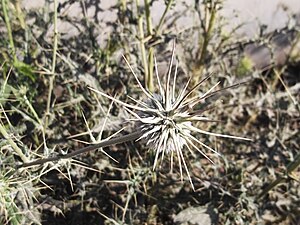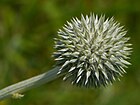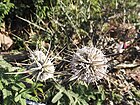Note: This is a project under development. The articles on this wiki are just being initiated and broadly incomplete. You can Help creating new pages.
Difference between revisions of "Echinops echinatus"
| (One intermediate revision by the same user not shown) | |||
| Line 1: | Line 1: | ||
[[File:Echinops echinatus-4-jodhpur-India.JPG|thumb|right]] | [[File:Echinops echinatus-4-jodhpur-India.JPG|thumb|right]] | ||
| − | + | '''Echinops echinatus''' is an erect, spiny, annual plant with branches spreading widely from the base, It grows from a taproot, it can reach 30 - 100cm tall. It is a xerophytic herbaceous plant<ref name="NCBI - NLM Usnakantaka"/>. The plant is commonly harvested from the wild for use as a medicinal herb in India. It is sold in local markets. This plant is belongs to Asteracea family. <ref name="Plant family"/> | |
| − | '''Echinops echinatus''' is an erect, spiny, annual plant with branches spreading widely from the base, It grows from a taproot, it can reach 30 - 100cm tall. The plant is commonly harvested from the wild for use as a medicinal herb in India. It is sold in local markets. This plant is belongs to Asteracea family. <ref name="Plant family"/> | ||
==Uses== | ==Uses== | ||
{{Uses|Coughs}}, {{Uses|Hysteria}}, {{Uses|Dyspepsia}}, {{Uses|Scrofula}}, {{Uses|Various eye problems}}, {{Uses|Brain disease}}, {{Uses|Chronic fever}}, {{Uses|Pains in the joints}}, {{Uses|Inflammations}}. | {{Uses|Coughs}}, {{Uses|Hysteria}}, {{Uses|Dyspepsia}}, {{Uses|Scrofula}}, {{Uses|Various eye problems}}, {{Uses|Brain disease}}, {{Uses|Chronic fever}}, {{Uses|Pains in the joints}}, {{Uses|Inflammations}}. | ||
| Line 71: | Line 70: | ||
<ref name="How to plant/cultivate">[http://temperate.theferns.info/plant/Echinops+echinatus Cultivation]</ref> | <ref name="How to plant/cultivate">[http://temperate.theferns.info/plant/Echinops+echinatus Cultivation]</ref> | ||
<ref name="Plant family">Karnataka Aushadhiya Sasyagalu By Dr.Maagadi R Gurudeva, Page no:237</ref> | <ref name="Plant family">Karnataka Aushadhiya Sasyagalu By Dr.Maagadi R Gurudeva, Page no:237</ref> | ||
| + | <ref name="NCBI - NLM Usnakantaka">Ethnomedicinal review of Usnakantaka (Echinops echinatus Roxb.) [https://www.ncbi.nlm.nih.gov/pmc/articles/PMC4557238/]</ref> | ||
</references> | </references> | ||
Latest revision as of 11:25, 25 January 2024
Echinops echinatus is an erect, spiny, annual plant with branches spreading widely from the base, It grows from a taproot, it can reach 30 - 100cm tall. It is a xerophytic herbaceous plant[1]. The plant is commonly harvested from the wild for use as a medicinal herb in India. It is sold in local markets. This plant is belongs to Asteracea family. [2]
Contents
- 1 Uses
- 2 Parts Used
- 3 Chemical Composition
- 4 Common names
- 5 Properties
- 6 Habit
- 7 Identification
- 8 List of Ayurvedic medicine in which the herb is used
- 9 Where to get the saplings
- 10 Mode of Propagation
- 11 How to plant/cultivate
- 12 Commonly seen growing in areas
- 13 Photo Gallery
- 14 References
- 15 External Links
Uses
Coughs, Hysteria, Dyspepsia, Scrofula, Various eye problems, Brain disease, Chronic fever, Pains in the joints, Inflammations.
Parts Used
[[:Category:Herbs with used in medicine|]], stem, leaves, Root.
Chemical Composition
Common names
| Language | Common name |
|---|---|
| Kannada | ಬ್ರಹ್ಮದಂಡೆ, Brahmadande |
| Hindi | |
| Malayalam | |
| Tamil | |
| Telugu | |
| Marathi | |
| Gujarathi | |
| Punjabi | |
| Kashmiri | |
| Sanskrit | 'Ushnakantaka' |
| English | Globe thistle |
Properties
Reference: Dravya - Substance, Rasa - Taste, Guna - Qualities, Veerya - Potency, Vipaka - Post-digesion effect, Karma - Pharmacological activity, Prabhava - Therepeutics.
Dravya
Rasa
Guna
Veerya
Vipaka
Karma
Prabhava
Habit
Identification
Leaf
| Kind | Shape | Feature |
|---|---|---|
| Alternately arranged | Oblong | Deeply pinnatified |
Flower
| Type | Size | Color and composition | Stamen | More information |
|---|---|---|---|---|
| Spherical | 3-5cm across | White | Surrounded by straight | {{{5}}} |
Fruit
| Type | Size | Mass | Appearance | Seeds | More information |
|---|---|---|---|---|---|
Other features
List of Ayurvedic medicine in which the herb is used
Where to get the saplings
Mode of Propagation
How to plant/cultivate
Requires a sunny position in a well-drained soil of low to medium fertility.[5]
Commonly seen growing in areas
[[:Category:Herbs that are commonly seen in the region of |]], [[:Category:Herbs that are commonly seen in the region of |]], [[:Category:Herbs that are commonly seen in the region of |]], [[:Category:Herbs that are commonly seen in the region of |]], [[:Category:Herbs that are commonly seen in the region of |]].
Photo Gallery
References
External Links
- Ayurvedic Herbs known to be helpful to treat Coughs
- Ayurvedic Herbs known to be helpful to treat Hysteria
- Ayurvedic Herbs known to be helpful to treat Dyspepsia
- Ayurvedic Herbs known to be helpful to treat Scrofula
- Ayurvedic Herbs known to be helpful to treat Various eye problems
- Ayurvedic Herbs known to be helpful to treat Brain disease
- Ayurvedic Herbs known to be helpful to treat Chronic fever
- Ayurvedic Herbs known to be helpful to treat Pains in the joints
- Ayurvedic Herbs known to be helpful to treat Inflammations
- Herbs with used in medicine
- Herbs with stem used in medicine
- Herbs with leaves used in medicine
- Herbs with Root used in medicine
- Herbs with common name in Kannada
- Herbs with common name in Sanskrit
- Herbs with common name in English
- Habit - Annual
- Index of Plants which can be propagated by Seeds
- Herbs that are commonly seen in the region of
- Herbs




